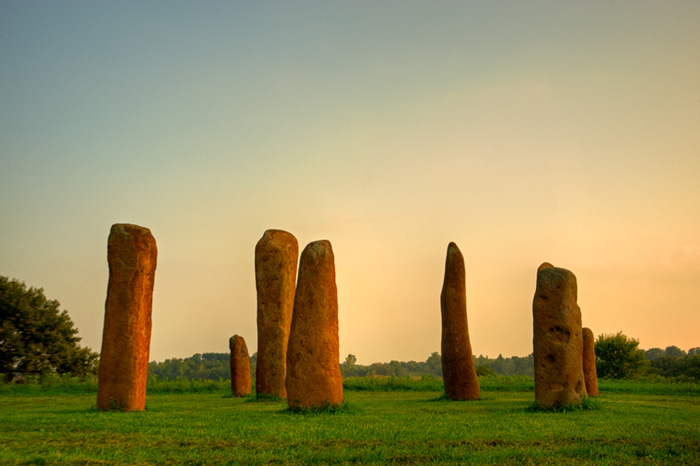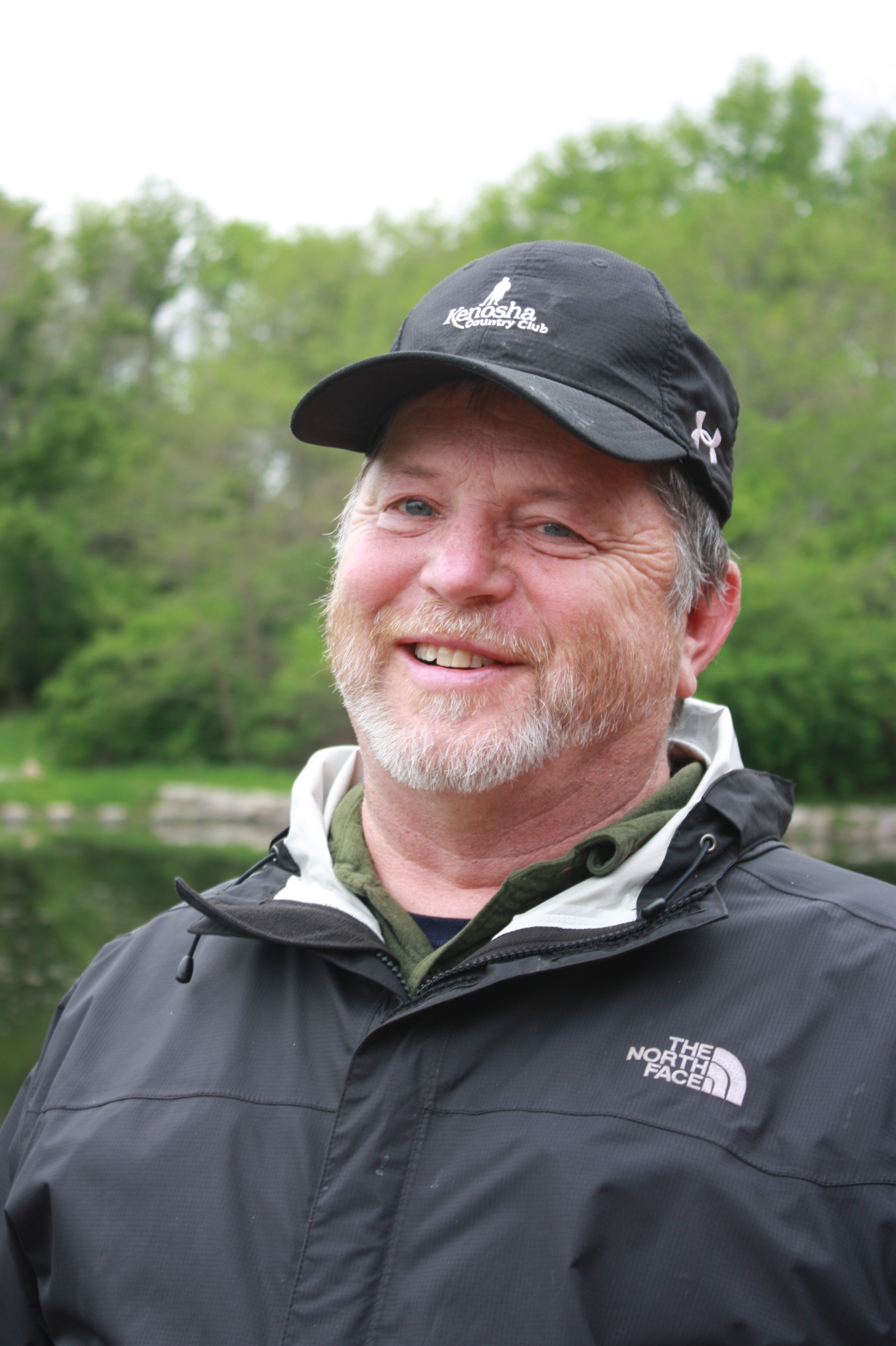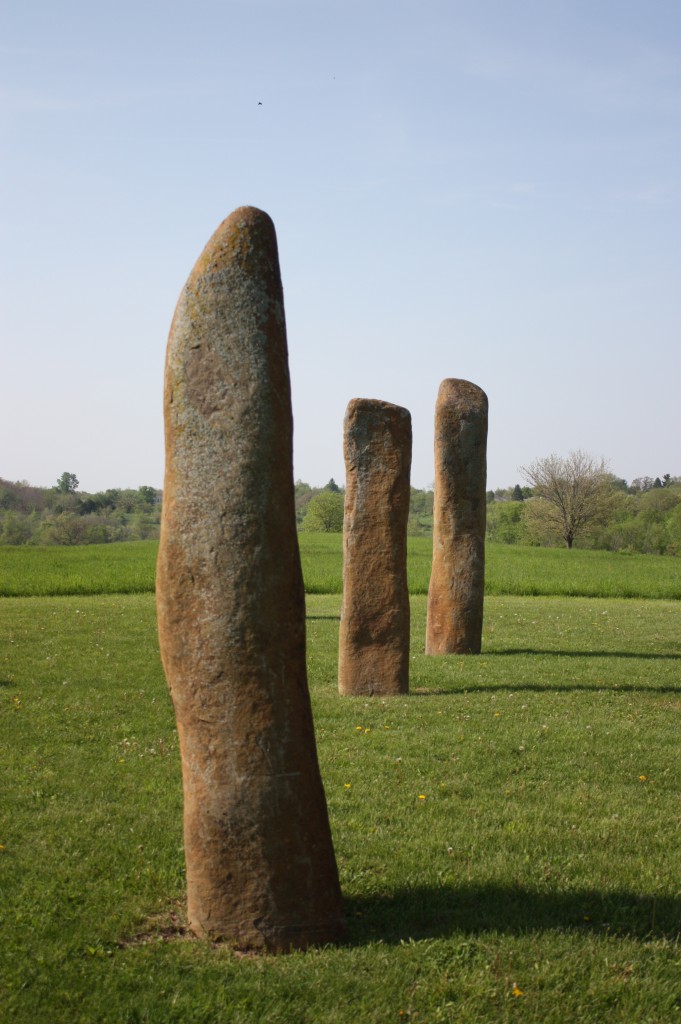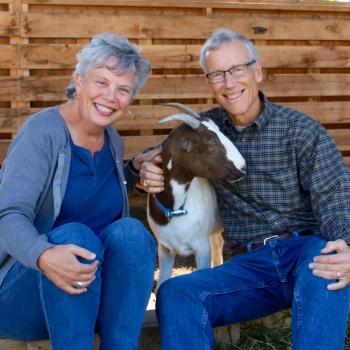
You might think that this picture was taken in Ireland or Scotland, places well-known for their prehistoric stone circles. But would you believe these stones are found in Iowa? Their story involves a remote island in Indonesia, a whimsical businessman with a deep commitment to spirituality, and (I’m not making this up) hobbits. Even by Holy Rover standards, this is an unusual sacred place, one that I’m delighted to have found.
There’s a certain sense of irony in my discovery of this place. I’ve traveled many thousands of miles across the world to see a multitude of holy sites, but here, all along, was a perfectly wonderful place just a short distance from my home in Iowa City. Over the years I’ve biked and driven by it dozens of times without realizing it was there. And in a final piece of irony, it took my friends Annechien and Hanno visiting from Amsterdam for me to discover it (many thanks to Jody and Ron, too, for taking us there on a windswept and rainy April afternoon).
The story of these sacred stones in the middle of Iowa begins on the small island of Flores in Indonesia. Little is known of their origin or purpose, except that they were quarried with stone chisels at least 4,000 years ago and were at one time arranged in a circle. In 2001 the residents of the island decided to get rid of them, prompted by the Taliban’s destruction of the Bamiyan Buddhas of Afghanistan (although the island of Flores is primarily Christian, at the time there was a let’s-get-rid-of-all-pagan-monuments mood in the air).

That’s when Doug Paul of Iowa City enters the story. An antiquities dealer from Chicago told him of the Indonesian sacred circle that needed a home. Doug arranged for the stones to be brought to Iowa by ship, train and flat-bed truck, a process that took more than a year. The basalt stones range in size from 16 to 30 feet, each weighing between 3,000 and 20,000 pounds.
“It sounds strange, but I felt like the stones were sending me a message,” says Doug. “For whatever reason, they wanted to be here in Iowa. And actually, if you send a line straight down through the center of the earth from Iowa, the nearest land mass on the other side is Indonesia, so maybe there is some connection between the two places.”
While Doug originally thought he might erect the stones in an existing public park, he and his wife, Linda, decided instead to purchase a place for them on the outskirts of Iowa City. Two farms were in danger of being turned into housing developments, and Doug and Linda felt that their mission was to save the land as well as find a home for the stones.
“From the very beginning of this effort, I felt like I was put on a need-to-know-basis,” he says. “At each step I found out what I needed to know to go forward, but I didn’t get all the answers I wanted. I still don’t have them. I’m a pretty unlikely person to make this happen, but it felt like something I was called to do.”
Today Harvest Preserve is a spiritual sanctuary of 100 acres on the northeast side of Iowa City. Its grounds include a charming boathouse overlooking a pond, several large areas of restored prairie, and thick woods laced with walking trails. The property is owned by a non-profit foundation that will ensure its existence for many generations to come—a testimony to the incredible generosity of Doug and Linda.

One of the pleasures of exploring Harvest Preserve are the pieces of art that appear in unexpected places. In a sun-dappled area called Whitman’s Glade, for example, is They Are Waiting, a piece by Nigerian-born artist Nnamdi Okonkwo. And across the road from Harvest Preserve sits Man on a Bench, a massive, 20-foot-tall sculpture being carved from 110 tons of Indiana limestone by Doug Paul and fellow artist J.B. Barnhouse.
“I think that figure has been there for at least 10,000 years, but he was finally brought out of the ether by our efforts,” says Doug.

You might think that Doug Paul sounds a little eccentric, but he’s actually a highly successful entrepreneur. Most of all, he’s a spiritual seeker and a dreamer, and he created Harvest Preserve as a gift to other spiritual seekers and dreamers (as one myself, I am truly grateful for the gift Doug and Linda have given to the larger world).
While the land is now governed by the Harvest Preserve Foundation board, the Paul family remains intimately involved. Doug and Linda’s daughter, Julie Decker, serves as program director, and Doug devotes much of his time to maintaining and nurturing the property, gradually bringing back more of its native flora and fauna.
“I used to own the land, and now it owns me,” says Doug. “I’m its full-time volunteer.”
As Harvest Preserve enters its second decade, its board is trying to strike a balance between public access and protecting it as a place for quiet contemplation. While there are events open to all, entrance is generally limited to members who pay a fee that helps with maintenance costs (people can also do volunteer work to pay for a membership). Some of the most frequent visitors to the preserve are children, brought as part of after-school programs.

I’ve only known the Harvest Preserve for a few weeks, but already it’s become a spiritual home for me. I love its winding paths through the woods, its quiet pond by the boathouse and its vistas of Iowa sky and prairie. But most of all, I love the Sacred Stone Circle that sits on a hill overlooking the woods, next to a meadow that is always atwitter with birdsong. Each time I come here I feel refreshed and at peace—the true mark of a holy place.
“As far as I know, this is the only stone circle transported in its entirety to the U.S.,” says Doug. “I think the stones talk to each other and talk to the land. They make it easier for people to connect with the divine energy that flows everywhere, but which seems to accumulate in some spots in particular. For whatever reason, they wanted to be here.”
Here’s another curious fact about Flores, the island where the stones originated. In 2003, archaeologists found the remains of nine short hominids estimated to have lived some 18,000 years ago. The discovery, which disrupted what scientists thought they knew about human evolution, made headline news around the world. The diminutive people (who stood about three and a half feet tall) have been dubbed, naturally, Hobbits.
We’ll likely never know if there’s any connection between these so-called Hobbits and the sacred stones. But when I took a friend to Harvest Preserve, she said something that rang true to me: “This place is magical.” And the more I think about it, the more I believe this is true. Harvest Preserve is a place where the veil between worlds is thin, where stone men appear out of the ether, and where circles of sacred stones are transported across space and time to grow in fertile Iowa soil.















